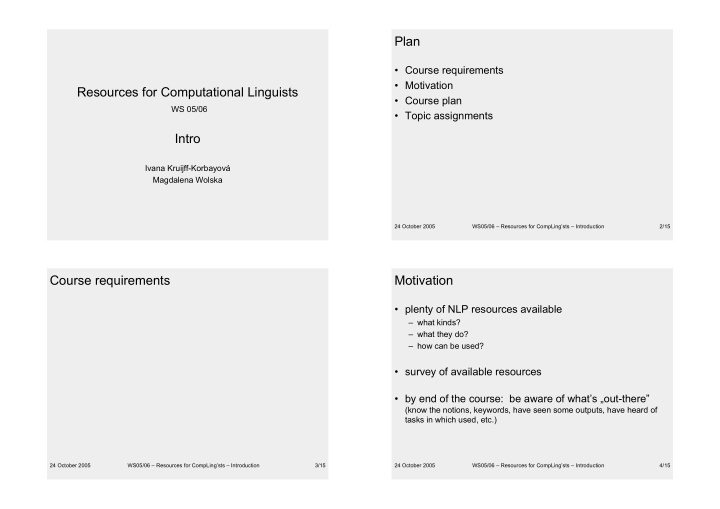



Plan • Course requirements • Motivation Resources for Computational Linguists • Course plan WS 05/06 • Topic assignments Intro Ivana Kruijff-Korbayová Magdalena Wolska 24 October 2005 WS05/06 – Resources for CompLing’sts – Introduction 2/15 Course requirements Motivation • plenty of NLP resources available – what kinds? – what they do? – how can be used? • survey of available resources • by end of the course: be aware of what’s „out-there” (know the notions, keywords, have seen some outputs, have heard of tasks in which used, etc.) 24 October 2005 WS05/06 – Resources for CompLing’sts – Introduction 3/15 24 October 2005 WS05/06 – Resources for CompLing’sts – Introduction 4/15
Motivation Motivation examples of NLP applications typical pipeline – user interfaces (e.g. voice-operated robots) – question answering (www.ask.com) NLP speech/text in speech/text out – information retrieval – dialog systems (e.g. DB, ATT customer service) – summarization – text seneration (e.g. automatic reporting from data, proof verbalization) 24 October 2005 WS05/06 – Resources for CompLing’sts – Introduction 5/15 24 October 2005 WS05/06 – Resources for CompLing’sts – Introduction 6/15 Motivation Motivation typical pipeline typical pipeline NLP NLP speech/text out speech/text out speech/text in speech/text in – pre-process input � some sub-components of every NLP module are „standard” � certain methods and tools are „standard” – shallow process and/or deep process • extract linguistic information � tools and resources can be and are re-used • add information � or are used to create other resources • infer information – decide on contextually meaningful output 24 October 2005 WS05/06 – Resources for CompLing’sts – Introduction 7/15 24 October 2005 WS05/06 – Resources for CompLing’sts – Introduction 8/15
Motivation Motivation typical pipeline typical pipeline NLP NLP speech/text in speech/text out speech/text in speech/text out a n a l y z e c o r p o r a – pre-process input a n a l y z e c o r p o r a – pre-process input tokenization – shallow process and/or deep process – shallow process and/or deep process • extract linguistic information • extract linguistic information • add information • add information • infer information • infer information – decide on contextually meaningful output – decide on contextually meaningful output 24 October 2005 WS05/06 – Resources for CompLing’sts – Introduction 9/15 24 October 2005 WS05/06 – Resources for CompLing’sts – Introduction 10/15 Motivation Motivation typical pipeline typical pipeline NLP NLP speech/text out speech/text out speech/text in speech/text in a n a l y z e c o r p o r a – pre-process input a n a l y z e c o r p o r a – pre-process input tokenization tokenization – shallow process and/or deep process – shallow process and/or deep process tagging, chunking, tagging, chunking, • extract linguistic information • extract linguistic information syntactic, semantic parsing, syntactic, semantic parsing, • add information • add information lexical analysis, lexical analysis, • infer information • infer information domain-specific reasoning domain-specific reasoning planning – decide on contextually meaningful output – decide on contextually meaningful output 24 October 2005 WS05/06 – Resources for CompLing’sts – Introduction 11/15 24 October 2005 WS05/06 – Resources for CompLing’sts – Introduction 12/15
Motivation Course outline typical pipeline NLP speech/text in speech/text out l e a n a l y z e c o r p o r a – pre-process input tokenization a r n – shallow process and/or deep process f tagging, chunking, • extract linguistic information r o syntactic, semantic parsing, m • add information lexical analysis, • infer information domain-specific reasoning c o r planning – decide on contextually meaningful output p o r a 24 October 2005 WS05/06 – Resources for CompLing’sts – Introduction 13/15 24 October 2005 WS05/06 – Resources for CompLing’sts – Introduction 14/15 Topic assignments Motivation typical pipeline NLP speech/text out speech/text in l e a n a l y z e c o r p o r a – pre-process input tokenization a r n – shallow process and/or deep process f tagging, chunking, • extract linguistic information r o syntactic, semantic parsing, m • add information lexical analysis, • infer information domain-specific reasoning c o r planning – decide on contextually meaningful output p o r a 24 October 2005 WS05/06 – Resources for CompLing’sts – Introduction 15/15 24 October 2005 WS05/06 – Resources for CompLing’sts – Introduction 16/15
Motivation typical pipeline NLP speech/text in speech/text out l e a n a l y z e c o r p o r a – pre-process input tokenization a r n – shallow process and/or deep process f tagging, chunking, • extract linguistic information r o syntactic, semantic parsing, m • add information lexical analysis, • infer information domain-specific reasoning c o r planning – decide on contextually meaningful output p o r a 24 October 2005 WS05/06 – Resources for CompLing’sts – Introduction 17/15
Recommend
More recommend